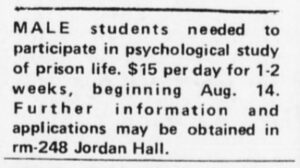In 1971, Philip Zimbardo conducted a highly controversial experiment that would become infamous. His research question: Why were prison guards violent? What drove them to violence? Was it their personalities? Was it their environment? In order to study this, Dr. Zimbardo created a prison-like environment in the basement of the Psychology building at Stanford University.
There were 10 prisoners and 11 guards, who were recruited through a newspaper ad (below). These participant were all randomly assigned to their roles, prisoner or prison guard. Zimbardo himself would be a researcher, but also play the role of Prison Warden.

The Prisoners
The participants who were assigned prisoner were actually arrested at their own home. However, there was absolutely no warning (which actually broke the consent form the participants signed prior to the experiment beginning). They were handcuffed, had their finger prints taken, and processed like real criminals would be at the police station. Then, they were blindfolded and driven to the makeshift prison at the university. Prisoners were held in small cell rooms, with two other prisoners. Upon arrival, the prisoners were strip searched, had their possessions taken away from them, and were given prison clothes. On their clothes/uniform, there was an ID code. From that point forward, they were only addressed as their ID number. This is how Zimbardo and the other researchers began the processes of deindividualization, or trying to get the prisoners to lose their sence of self.

The Guards
The guards, on the other hand, were split into groups and given shifts each day. They were dressed in matching uniforms, a club in hand, and dark sunglasses (to inhibit eye contact with prisoners). The researchers told them to do what, in their opinion, was needed in order to maintain obiedience and structure within the prison. Prison guards quickly began to harass and insult the prisoners, verbally, as well as give them demeaning tasks meant to strip them of their dignity.
Prisoners were beginning to follow the rules strictly, in fear of having a punishment given to them. Prisoners became submissive to the guards, which in turn made the guards more aggressive. On day two, prisoners created a rebellion, which endly badly for them. The prisoners were harassed, and the leader of the rebellion was placed in solitary confinement as punishment. One prisoner was actually released after a day and a half into the experiment. He was beginning to show signs of depression. Eventually, other prisoners had to leave the experiment early, due to emotional distress that could have had long-term effects on their psychological state. After six days, the experiment was forced to shut down early.

The results of this study show that the power of a situation can heavily impact whether someone will conform to certain roles or not. These findings support Dr. Zimbardo’s hypothesis of the situation being the strongest driving force for prison guards, rather than their personalities. As for the prisoners, they became submissive because of the deindividualization process and their learned dependency on the guards. They lost their sense of self by being referred to as a number and not having their personal belongings. During interviews after the experiment had concluded, both groups of participants were surprised with the way that they behaved.
Additional Resources
- Haney, C., Banks, W. C., & Zimbardo, P. G. (1973). A study of prisoners and guards in a simulated prison. Naval Research Review, 30, 4-17.
- Psychology and Stuff Podcast: The Stanford Prison Experiment. https://blog.uwgb.edu/uwgbpsych/psychology-and-stuff-the-stanford-prison-experiment/
- Psychology and Stuff Podcast: The Stanford Prison Experiment… Part 2. https://blog.uwgb.edu/uwgbpsych/psychandstuff22/
- http://www.simplypsychology.org/zimbardo.html
- http://www.prisonexp.org/
- https://www.psychologytoday.com/blog/freedom-learn/201310/why-zimbardo-s-prison-experiment-isn-t-in-my-textbook